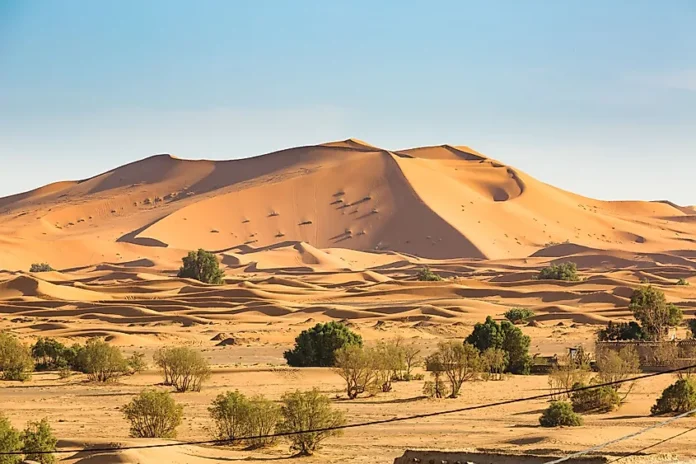Satellite images have revealed a surprising transformation in parts of the Sahara Desert, showing patches of green emerging in a region typically known for its extreme aridity. The vast expanse of the Sahara, the world’s largest hot desert, has long been one of the driest places on Earth. Yet, these new images captured by NASA highlight an unexpected burst of life, with shrubs and small trees taking root in areas across Morocco, Algeria, Tunisia, and Libya.
This green phenomenon is not without precedent, but its suddenness has taken scientists by surprise. Historically, the Sahara has experienced several cycles of greening, the most recent one being between 11,000 and 5,000 years ago during a period known as the African Humid Period. During that time, changes in the Earth’s axial tilt brought the Northern Hemisphere closer to the sun, creating a low-pressure system that pulled moisture into the desert. These shifts, driven by the Earth’s orbital variations, have triggered over 230 such greening episodes in the Sahara over the last eight million years. On average, these cycles occur every 21,000 years.
Incredible moment the Sahara turns green – and scientists aren’t completely sure why https://t.co/LXbiTm5k6n
— Ted Joy (@TedJoy71) October 4, 2024
However, the current burst of greenery is tied to a much more immediate and unusual weather event. On September 7 and 8, an extratropical cyclone swept through northwestern Africa, bringing torrential rains to a region that rarely sees such weather. In some areas, more than 15 centimeters (over half a foot) of rain fell—an astonishing amount for a desert that typically receives less than eight centimeters of rainfall annually. This deluge was primarily concentrated in riverbeds and low-lying areas, which have since turned green as vegetation quickly responded to the moisture.
While these isolated areas of greenery are visually striking, the overall consequences of the cyclone were devastating for many communities. Flash floods resulting from the storm claimed the lives of more than a thousand people and displaced millions across 14 African nations, including parts of the Sahel. According to the World Food Programme and the Associated Press, the floods also damaged infrastructure, disrupted power grids, and left many without access to clean water.
Comparing current vegetation over Africa with a year ago …
Recent unusual rain over the southern Sahara Desert has resulted in a noticeable change in greenery. pic.twitter.com/4agN8TuD5k
— Dr. Mathew Barlow (@MathewABarlow) September 12, 2024
The catalyst behind this extraordinary weather event lies in the movement of the Intertropical Convergence Zone (ITCZ). This tropical rain belt, which usually stays closer to the equator, shifted unusually far north, driven by the convergence of winds from the Southern Hemisphere and the Northern Hemisphere. The convergence, combined with the Sahara’s intense sun and the warming of nearby ocean waters, created the perfect conditions for sustained rainfall, cloud cover, and thunderstorms over the normally dry desert.
Moshe Armon, a senior lecturer at the Institute of Earth Sciences and Hebrew University of Jerusalem, explained the uniqueness of the event: “While there is some degree of rainfall in this region every summer, what’s unique this year is the involvement of an extratropical cyclone.” It’s this combination of rare meteorological factors that has brought about a temporary greening of the Sahara, demonstrating just how responsive the desert can be when it receives adequate rainfall.


